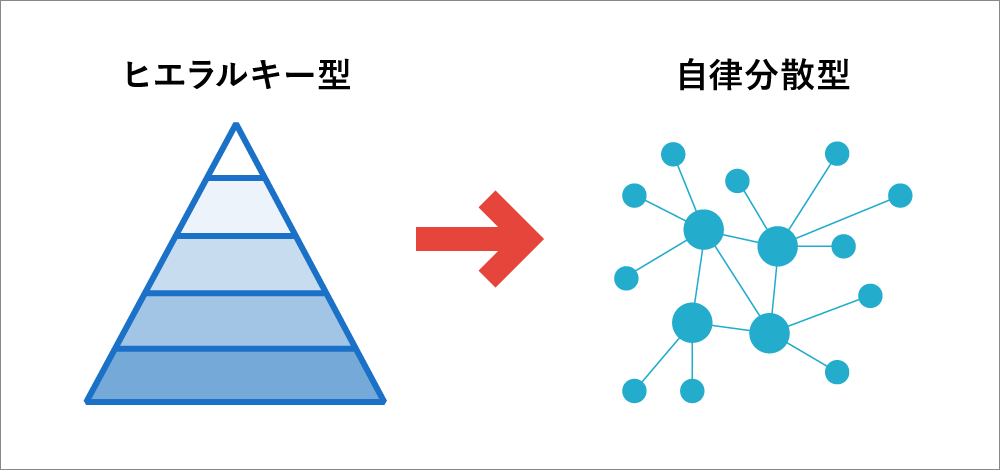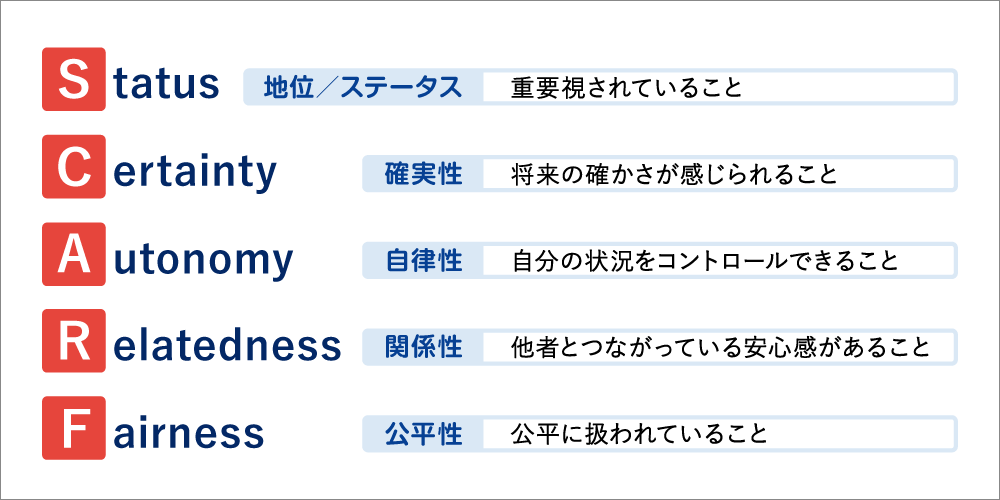As remote work becomes widespread in Japanese companies during the COVID-19 pandemic, awareness of the importance of "internal communication" is rapidly increasing. Last time, we introduced the basic framework for planning and designing it.
This time, we introduce the latest trends in internal communication.
"We've implemented basic measures so far, but we want to consider more effective approaches."
We hope this serves as a reference for those with this advanced level of awareness.
Organizational Structures: Shifting from "Hierarchical" to "Autonomous and Decentralized"
When considering the latest trends in internal communication, it's crucial to first recognize that the structure demanded of organizations is undergoing significant transformation.
Figure 1: Organizations are shifting from "hierarchical" to "autonomous and decentralized"

In the VUCA(※) environment—characterized by volatility, uncertainty, complexity, and ambiguity—and its rapid changes, generating innovation with speed is crucial. Centralized, top-down management approaches based solely on hierarchical structures are no longer sufficient. What is now required is an autonomous, decentralized collaboration style where each frontline employee thinks independently, acts proactively, and collaborates freely across boundaries.
The pandemic, which effectively forced the adoption of remote work, has further accelerated this necessity.
※=VUCA
An acronym for Volatility, Uncertainty, Complexity, and Ambiguity
On the other hand, reduced communication with supervisors and colleagues during remote work has led to a decline in employees' sense of unity and belonging within the organization. Top management, starting with the CEO, must now proactively communicate the company's vision and their current thinking more than ever before to maintain and strengthen the organizational culture.
Challenges in internal communication to adapt to new organizational structures are emerging in various areas. This time, I will explain three major trends I see emerging from these challenges.
1. Seamless Integration of Internal and External Communication
Traditionally, internal communication and external (outside the company) communication were considered separate entities, each deployed with optimized tools and content tailored to their specific purpose.
However, in today's rapidly changing environment, internal communication now demands greater speed. Furthermore, the proliferation of social media has made corporate inner workings increasingly transparent, making open communication about workplace environments and corporate culture crucial from a corporate branding perspective.
Amidst this, a trend has emerged where companies are developing their owned media not only for branding to external stakeholders but also to serve as a tool for internal communication.
A prime example of this is Toyota Motor Corporation's "Toyota Times."
Figure 2: "Toyota Times" Capture Image

While positioning owned media as the core for information dissemination and coordinating with mass media to promote the company's latest developments, Toyota Times also actively shares updates on union negotiations and President Akio Toyoda's "current thoughts." This content clearly reflects a strong focus on communicating with employees.
Leveraging owned media enables swift communication of top-level vision down to the grassroots level of the organization. The communication power of corporate leadership is also a crucial element from a corporate branding perspective. This dual-track approach to internal and external communication, driven by the top leadership's active commitment, represents a noteworthy new trend in internal communication.
2. The Challenge of "Large-Scale Online Meetings"
Currently, large-scale internal communication events like company-wide assemblies are difficult to hold in person. Furthermore, with new hires primarily working remotely and limited office attendance, many companies face challenges in workplace adaptation and development. In this environment, an increasing number of companies are attempting large-scale online meetings involving hundreds of participants.
Examples are emerging where companies utilize web conferencing systems to enable top executives to hold interactive meetings with all new hires, or to conduct ideathons led by junior employees. Companies are currently exploring the necessary system environments and facilitation skills for this purpose.
A key future challenge will be adding an element of entertainment to make participation enjoyable for employees. Large-scale online meetings require skills akin to "program production" – creating a cohesive, high-quality content experience within the limited environment of a web conferencing system, combining slide materials, videos, and dialogue.
One promising solution gaining attention is collaborating with media outlets and celebrities to develop events. Examples already exist, such as company-wide meetings for thousands of employees and job offer ceremonies gathering students scattered worldwide. The trend of leveraging media's content production expertise and networks with celebrities for internal communication is expected to accelerate.
3. Communication Focused on "Psychological Safety"
To embed a "self-directed, decentralized collaboration style" within an organization—where every frontline employee thinks independently, acts autonomously, and collaborates freely—the "mindset" is as crucial as the communication "methods." This is why the concept of "psychological safety" is gaining significant attention.
Psychological safety refers to "the belief that one will not be punished or humiliated for voicing ideas, questions, concerns, or mistakes." In an autonomous, decentralized organization, each employee is expected to take initiative and challenge themselves in daily work. If they fear failure, or being blamed or humiliated for mistakes, innovation cannot flourish. Management, including executives, must be highly conscious of creating an organizational culture that ensures psychological safety to maximize employee potential.
So, what kind of communication should be prioritized on a daily basis? The framework proposed by David Rock of the NeuroLeadership Institute and others is the "SCARF Model" shown below.
Figure 3: SCARF Model

To ensure psychological safety, each employee must feel:
- feel they are valued as individuals
- Organizational policies are perceived as clear
- feel that their autonomous actions are supported
- feel that their humanity is respected within their connections with others
- and feel they are treated fairly and equally.
are essential. The aforementioned top-down information dissemination, creating meeting spaces, and designing messages mindful of the SCARF model represent the fundamental tone and manner for internal communication going forward.
Internal communication in the new normal era is not merely about "digitizing initiatives." It requires establishing new collaboration styles within organizations where remote work has become the norm. This demands a shift in mindset—how management and each individual employee approaches and engages with others.






